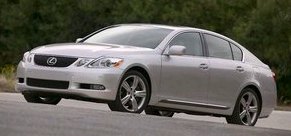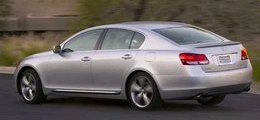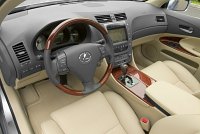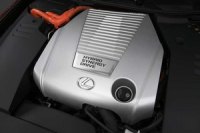|
Lexus GS
Debut: 2005
Maker: Toyota
Predecessor: Lexus GS / Toyota Aristo Mk2
|
|
 Talk
about Lexus GS, what will you think of? You may remember the Giugiaro
styling of the original GS and the V8 power of the second generation
car, but probably nothing else. Why? Because Lexus GS had never been
competitive enough to fight against class leader BMW 5-Series and
Mercedes E-class. Can the third generation GS close the gap? Talk
about Lexus GS, what will you think of? You may remember the Giugiaro
styling of the original GS and the V8 power of the second generation
car, but probably nothing else. Why? Because Lexus GS had never been
competitive enough to fight against class leader BMW 5-Series and
Mercedes E-class. Can the third generation GS close the gap?
In terms of styling, the answer is definitely positive. Although it is
not as elegant as Audi A6 and Jaguar S-Type, the new GS is a fine piece
of design. Its body profile is smoother and sleeker than before, thanks
to faster-angle windscreen and fastback-like rear window.
Simultaneously, the pronounced shoulder line and taller / shorter tail
contribute to a sportier appearance. What a pity the clumsy headlamps
and characterless grille devoid it of a prestige image.
Enter the cabin, you will be amazed by its simplicity. The dashboard is
very clean, almost too lean. At first, you may find the plastic surface
too shinny, without the quality feel of Audi's cabin. But then examine
the assembly gap and the hinges of moving parts you will find build
quality is actually first rate. It will last forever. In terms of
space, there is hardly any surprise. It matches its main rivals but no
more.
What allows the dashboard design to be so clean is the clever use of a
retractable control panel to place those rarely used buttons, keeping
them out of sight in normal driving. Furthermore, Lexus cleverly uses a
touch screen to control more complicated functions such as navigation.
This is far more user friendly than BMW's rotary knob-controlled
i-Drive. Ease of use continues to be a strength of Lexus.
Chassis and Systems
The outgoing GS shared platform and engines with the Japan-bounded
Toyota Crown to benefit economy of scale - that’s why it can be sold at
lower price yet lower volume than its German rivals. This strategy
continues in the latest car. As before, the new GS is a rear-drive
machine powered by a six-cylinder and a V8 engine. However, it is not
lack of new technologies:
1)
Optional 4WD system: this feature is only available to GS300. It uses
an electronic-controlled multi-plate clutch to deliver 70% torque to
the rear wheels in normal condition to maintain rear-biased handling
character, and up to 50% torque to the front wheels when the road get
slippery.
2)
New
suspensions: while the front remains to be double-wishbones, the rear
suspensions have been changed to a multi-link setup. Adaptive damping
is available to GS430.
3)
6-speed gearbox: like LS430, the automatic gearbox is upgraded from
5-speed to 6-speed. This should improve acceleration and reduce fuel
consumption. Note that Lexus still resists manual gearbox, a reflection
of its comfort-biased nature.
4)
Brake-by-wire: following the footprints of Mercedes' SBC system, Lexus
GS is also introducing its own version of brake-by-wire system called
ECB (Electronic-Controlled Braking). Will it be as problematic as
Mercedes' system? we shall see later.
5)
Variable gear ratio steering (VGRS): this is similar to BMW's AFS
system but work in a more civilized manner (that means a smaller range
of variation). The steering gear ratio can be varied electrically
according to speed - at below 50km/h, the steering ratio is fixed at a
relatively high value, quickening steering response. Above that,
steering ratio is continuously reduced as a function of speed,
resulting in slower steering response. This makes the steering less
nervous and improves high-speed stability. Another important feature of
VGRS is its ability to correct understeer and oversteer. When VDIM
(Vehicle Dynamic Integrated Management) system tells it the car is
running in understeer or oversteer, VGRS can steer the front wheels
actively by up to 6 degrees to counter the understeer or oversteer. On
highway, it can also adjust the steering to compensate side wind. (Both
VGRS and VDIM are available to GS430 only)
Apart from VGRS, VDIM and ECB, the new GS also features the usual ABS,
BA (Brake Assist), EBD (Electronic Brakeforce Distribution), TRAC
(Traction Control) and VSC (Vehicle Stability Control). Who says only
the German are mad of electronic trickeries?
Engines and Performance
As before, Lexus offers a 4.3-litre V8 and a 3.0-litre six-cylinder
engine for the GS. They are called GS430 and GS300 respectively.
The V8 is carried over from the old car and is shared with LS430 as
well. It produces the same 300 horsepower and 325 lbft of torque,
propelling the car from 0 to 60 mph in 5.7 seconds and hitting a
regulated top speed of 155 mph. This compete well with BMW 545i,
Mercedes E500, Audi A6 4.2 and Infiniti M45.
 In contrast, GS300 employs a
new engine. In place of the long-serving iron-block inline-6 is an
all-aluminum V6 displacing the same capacity. Dual VVT-i, variable
intake manifolds and direct-injection helps it to lift maximum power
from 220 hp to 245 hp, which is very efficient indeed, if not as
efficient as BMW's 258hp 3.0 straight-six. In contrast, GS300 employs a
new engine. In place of the long-serving iron-block inline-6 is an
all-aluminum V6 displacing the same capacity. Dual VVT-i, variable
intake manifolds and direct-injection helps it to lift maximum power
from 220 hp to 245 hp, which is very efficient indeed, if not as
efficient as BMW's 258hp 3.0 straight-six.
Naturally, the new V6 is substantially shorter and lighter than the old
engine. It helps the new GS300 to undercut its predecessor by 50 kg.
Nevertheless, at 1620 kg, it is hardly a lightweight. Competing with
the lighter BMW 530i and the more powerful Mercedes E350 and Infiniti
M35, the GS300 inevitably feels a little short on power. Why didn't
Toyota give it the 280 horsepower 3.5-litre V6 recently applied to
Avalon? Perhaps the bigger V6 is not refined enough to match the Lexus
standard. But a more likely reason is: the V6 is reserved for the
forthcoming IS350, which is supposed to deliver a sportier drive than
the GS.
On the Road
For the first time, Lexus GS comes close to LS430 in quietness and
refinement. Sound insulation throughout the cabin is superb, making it
the quietest car of the class. The engines, no matter V6 or V8, are
remarkably smooth and quiet. The 6-speed automatic transmission shifts
seamlessly. In short, the “Lexus-ness” is obvious.
Ride quality is generally supple, but not as competent as Mercedes
E-class and BMW 5-Series. GS300 has a softer suspension which results
in more body movement. In contrast, GS430 with its adaptive damping and
sportier tires transmit too much shocks from small irregularities on
the
road, ruining the otherwise refined ride.
 Keen
drivers will once again find the Lexus not their cup of tea. Although
the hardware is promising - 53/47 to 54/46 weight distribution,
rear-wheel-drive, VGRS and VDIM etc. - Toyota still fails to put these
stuffs together properly to deliver real driving pleasure. Failure one
is the steering, which is light and uncommunicative; Failure two is the
brake-by-wire, whose pedal feel is detached, modulation is difficult
and way too sensitive. It really follows the footprints of Mercedes.
Failure three is the gearbox, which upshifts automatically even in
manual mode, leaving little control to the driver. But worse of all is
failure four – the electronics (VDIM, VSC or the like) intervenes too
keenly. Every time you want to exploit the chassis, it shut the car
down and call an end to the party. It is the Big Brother HAL9000. And
unlike “2001 The Space Odyssey”, you cannot disable the computer. Keen
drivers will once again find the Lexus not their cup of tea. Although
the hardware is promising - 53/47 to 54/46 weight distribution,
rear-wheel-drive, VGRS and VDIM etc. - Toyota still fails to put these
stuffs together properly to deliver real driving pleasure. Failure one
is the steering, which is light and uncommunicative; Failure two is the
brake-by-wire, whose pedal feel is detached, modulation is difficult
and way too sensitive. It really follows the footprints of Mercedes.
Failure three is the gearbox, which upshifts automatically even in
manual mode, leaving little control to the driver. But worse of all is
failure four – the electronics (VDIM, VSC or the like) intervenes too
keenly. Every time you want to exploit the chassis, it shut the car
down and call an end to the party. It is the Big Brother HAL9000. And
unlike “2001 The Space Odyssey”, you cannot disable the computer.
Conclusion
The GS follows the tradition of Lexus to offer the highest mechanical
refinement and build quality. It has a pair of good engines, a
comfortable cabin, nice exterior styling and a lot of sophisticated
technologies. However, it fails to deliver the ride and handling
necessary to compete with its best German rivals. In particular, its
driver interface provides little communication and control to the
driver, making the car unexciting to drive. Sadly, this is also the
tradition of Lexus. |
| The
above report was last updated on 25 Apr
2005. All Rights Reserved. |
GS450h
|
 You
can use electric-gasoline hybrid technology in two ways: A) to achieve
superior frugality without losing performance, or B) to achieve
superior performance without worsening fuel consumption. Lexus GS450h
belongs to the latter kind. According to Lexus’ traditional naming
policy, it should have been named “GS350h”. However, the combination of
a 292 hp 3.5-litre V6 and a 197 hp electric motor results in a maximum
339 horsepower, which sounds more like the output of a 4.5-litre V8,
hence
the name GS450h. You
can use electric-gasoline hybrid technology in two ways: A) to achieve
superior frugality without losing performance, or B) to achieve
superior performance without worsening fuel consumption. Lexus GS450h
belongs to the latter kind. According to Lexus’ traditional naming
policy, it should have been named “GS350h”. However, the combination of
a 292 hp 3.5-litre V6 and a 197 hp electric motor results in a maximum
339 horsepower, which sounds more like the output of a 4.5-litre V8,
hence
the name GS450h.
The petrol V6 is a detuned version of IS350’s. It has all the
efficiency-enhanced technologies like dual VVT-i and direct injection.
In the electric side, there is a NiMH battery pack added between the
rear seatback and the boot, supplying electricity to a big electric
motor. Another motor (a smaller one) works as starter and generator.
Mating the engine and the electric motor together is a new longitudinal
CVT. It provides an additional planetary gear set with 2 ratios to take
care of highway cruising as well as low speed acceleration.
The hybrid system in this car is not as economy-biased as Toyota Prius,
but it still drinks less fuel than its performance rivals like BMW
550i. Lexus claims it returns an excellent 27 mpg in city and 28 mpg on
highway, versus BMW’s 17 / 25 mpg. Although in reality most journalists
found those figures impossible to repeat, the hybrid vehicle still has
an edge over its German rivals, especially in city where the electric
motor provides a bigger contribution to power.
 On the
other hand, the electric motor provides very strong assistance right
from idle. This is the so-called “supercharging effect”. It enables the
GS450h to sprint from rest to 60 mph in 5.2 seconds, beating BMW 550i
by 0.1 seconds ! at higher speed, the supercharging effect fades out as
electric motor doesn’t excel at high rev, that’s why the sum of 292 hp
and 197 hp is 339 hp. By then you will see the advantage of BMW – it
possesses 20 more horses yet carries 150 kg less weight than the hefty
Japanese hybrid car. However, most American journalists did not notice
that, because their GS450h are electronically regulated to 131 mph. In
Europe, the speed limiter is set at 155 mph, so European drivers can
see the difference. On the
other hand, the electric motor provides very strong assistance right
from idle. This is the so-called “supercharging effect”. It enables the
GS450h to sprint from rest to 60 mph in 5.2 seconds, beating BMW 550i
by 0.1 seconds ! at higher speed, the supercharging effect fades out as
electric motor doesn’t excel at high rev, that’s why the sum of 292 hp
and 197 hp is 339 hp. By then you will see the advantage of BMW – it
possesses 20 more horses yet carries 150 kg less weight than the hefty
Japanese hybrid car. However, most American journalists did not notice
that, because their GS450h are electronically regulated to 131 mph. In
Europe, the speed limiter is set at 155 mph, so European drivers can
see the difference.
The continuous variable transmission is generally good. Its operation
is seamless in automatic mode (what else do you expect for CVT ?),
although there is still a little rubber band effect can be detected.
The CVT can also simulate a 6-speed manual gearbox, but it’s no
replacement to a real manual gearbox for responsiveness and feel.
The hybrid conversion has a couple drawbacks though. The first one is
luggage space. To accommodate the battery pack, the boot volume is
reduced by almost half ! this mean it cannot carry 4 people’s
belongings for long journey.
Another drawback is weight. The hybrid system added 175 kg to the kerb
weight. This mean while the car sounds like a 3.5-litre sedan, it
weighs like a 5.5-litre limousine ! GS has never matched BMW 5-series
for handling and ride. With the extra weight, its handling and ride can
only get worse.
And then the last factor you have to consider is price. Interestingly,
the number in its name serves not only as an indication to its power
level, but also an indication to its price. In the USA, the hybrid
version costs about 12 percent more than the V8-powered GS430. So, you
pay more money for lower fuel consumption and slightly quicker
acceleration (0-60 mph: 5.2 sec versus 5.7 sec), but you get an useless
boot and slight deterioration in handling. Apple or orange, that is
your choice. |
| The
above report was last updated on 20 Apr
2006. All Rights Reserved. |
|
|
|
General remarks
|
GS300
|
GS430 |
GS450h
|
Layout
|
Front-engined, RWD
|
Front-engined, RWD
|
Front-engined, RWD |
Chassis
|
Steel monocoque
|
Steel monocoque |
Steel monocoque |
Body
|
Mainly steel
|
Mainly steel |
Mainly steel |
| Length / width / height |
4825 / 1820
/ 1430 mm |
4825 / 1820
/ 1430 mm |
4825 / 1820
/ 1430 mm
|
| Wheelbase |
2850 mm |
2850 mm |
2850 mm |
Engine
|
V6, 60-degree
|
V8, 90-degree |
V6, 60-degree, electric motor
|
Capacity
|
2994 cc
|
4293 cc |
3456 cc
|
Valve gears
|
DOHC 24 valves, DVVT
|
DOHC 32 valves, VVT |
DOHC 24 valves, DVVT |
Induction
|
VIM
|
- |
-
|
Other engine features
|
DI
|
-
|
DI |
Max power
|
245 hp
|
300 hp |
292 hp (engine)
197 hp (motor)
339 hp (combined)
|
Max torque
|
230 lbft
|
325 lbft |
267 lbft (engine)
203 lbft (motor)
|
Transmission
|
6-speed automatic
|
6-speed automatic |
CVT
|
Suspension layout
|
F: double-wishbone
R: multi-link
|
F: double-wishbone
R: multi-link |
F: double-wishbone
R: multi-link |
Suspension features
|
-
|
- |
- |
Tyres front/rear
|
225/50VR17
|
245/40ZR18
|
245/40ZR18
|
Kerb weight
|
1620 kg
|
1695 kg
|
1875 kg
|
Top speed
|
143 mph (c)
|
155 mph (limited)
|
155 mph (limited)
|
0-60 mph (sec)
|
6.9*
|
5.7** / 5.7***
|
5.2 (c) / 5.5**
|
0-100 mph (sec)
|
17.8*
|
15.0** / 14.3***
|
13.3**
|
| Performance
tested by: |
*Autocar,
**C&D, ***R&T
|
|
GS350
|
GS460 |
|
Layout
|
Front-engined, RWD (4WD)
|
Front-engined, RWD
|
|
Chassis
|
Steel monocoque
|
Steel monocoque |
|
Body
|
Mainly steel
|
Mainly steel |
|
| Length / width / height |
4825 / 1820
/ 1425 mm |
4825 / 1820
/ 1425 mm |
|
| Wheelbase |
2850 mm |
2850 mm |
|
Engine
|
V6, 60-degree
|
V8, 90-degree |
|
Capacity
|
3456 cc
|
4608 cc |
|
Valve gears
|
DOHC 24 valves, DVVT
|
DOHC 32 valves, DVVT |
|
Induction
|
-
|
VIM
|
|
Other engine features
|
DI
|
DI
|
|
Max power
|
303 hp
|
342 hp
|
|
Max torque
|
274 lbft
|
339 lbft
|
|
Transmission
|
6-speed automatic
|
8-speed automatic |
|
Suspension layout
|
F: double-wishbone
R: multi-link
|
F: double-wishbone
R: multi-link |
|
Suspension features
|
-
|
- |
|
Tyres front/rear
|
225/50VR17
|
245/40ZR18
|
|
Kerb weight
|
1680 kg (4WD: 1700 kg)
|
1790 kg
|
|
Top speed
|
155 mph (limited)
|
155 mph (limited)
|
|
0-60 mph (sec)
|
5.7 (c)
5.3*** (4WD)
|
5.4 (c) / 5.5* / 5.6**
|
|
0-100 mph (sec)
|
13.3*** (4WD)
|
13.1* / 13.4**
|
|
| Performance
tested by: |
*C&D,
**MT, ***R&T
|
|
|